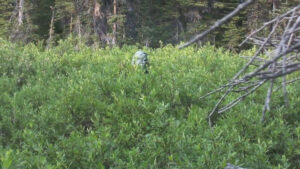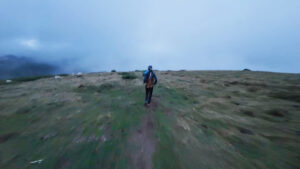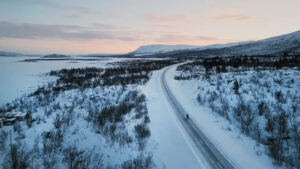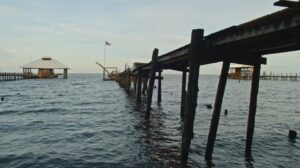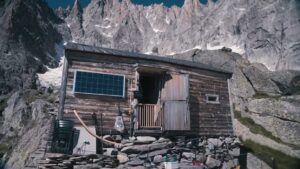What seemed like the hobbyhorse of a fool and a dreamer has become a model of rewilding.
Never did I expect to hear the familiar tone of a Kiwi accent come through this video. Much less a man speaking about a patch of land barely an hour from where I grew up, and less than a kilometre from where my grandmother went to school.
But that’s New Zealand for you, isn’t it? A population of merely five million somehow intertwined within one another. Our land — Aotearoa — sacred not just to our native Maori, but one we all know we are lucky to call home.
Many times, I have laced my trail runners and followed my nose along narrow trails, through wild grass, up hills and down, unaware that the land beneath my feet was this important.

Hinewai Reserve is a New Zealand ecological restoration project that has defied odds in turning gorse weed into a canopy under which native species thrive.
Hinewai Reserve (the Maori word means Water Maiden) is a private nature enclave spanning 1,250 hectares on the Banks Peninsula of New Zealand’s South Island. The region is mainly known for the small French settlement township of Akaroa, which is close enough to Christchurch for locals to visit over a weekend, and pleasant enough for tourists to add it to their itinerary of dolphin or whale encounters. At the same time, it’s an almost secret place, unusually quiet, but for the sound of birdsong.
The road from Christchurch passes over winding hills laden with hairpin turns, which have caused car sickness on many of my running missions. Birdlings Flat sits shortly before the last of the hills, leaving the impression that the city is behind and in front is a homage to wildlife. Ideal for a busload of awkward geology students on a forced field trip.

Just an hour from Christchurch, the Hinewai Reserve’s regeneration project began in the 1980s. Photo: Wilderness Magazine
Botanist Hugh Wilson perhaps felt the same way: that Banks Peninsula represents something unique.
Wilson is the manager of Hinewai. He’s someone who, if you happened upon his words out of context or written down, you’d perhaps think of like a mad professor-type person with a “greeny” attitude. Certainly, the locals did when they first encountered him. But he isn’t a hermit, doesn’t neglect self-care, or rebel against modern technology. He’s well-educated, incredibly intelligent, seems gentle, kind, and caring, and he lives and breathes nature. His colleagues say, “you can’t help but like him”, although by the way they say the phrase, it’s clear they are putting their adoration mildly.
Wilson’s primary goal is “to foster the natural regeneration of native vegetation and wildlife”. He wakes at 5 am with the same daily routine, bikes or walks to the section he’s working on for the day (sometimes a couple of hours each direction), and when the day’s work is complete, he spends hours into the night working on the administration needs of his mammoth conservation project.
Wilson’s always been keen on plants. He was brought up in Christchurch, to parents keen on the outdoors and camping. Once, the family visited Stewart Island (the southernmost of New Zealand’s islands, rich in wildlife thanks to few introduced predators). Here, Wilson first developed an interest in birds. He started by drawing them, then planted native plants in the family yard to attract them.
At St Andrew’s College, one of Christchurch’s most prestigious boys’ schools, he was dux (top pupil). Afterward, he joined the Voluntary Services Abroad program, stationed in Borneo. When he studied botany at university, he first discovered the Banks Peninsula.
In 1983, the Protected Natural Areas Programme (PNAP) was introduced, and New Zealand was divided into 268 ecological districts, grouped into 85 ecological regions. Banks Peninsula (with Herbert, Akaroa, and Port Hills) formed one region, and Wilson began fieldwork on the district.
For the next several years, as he tramped back and forth across the Banks Peninsula surveying the land (which he’d previously assumed to be “trashed”), he dreamed of an opportunity to look after some of it. In 1987, he brought 109 hectares of the land.
At the start of his initiative to create a regeneration project from the gorse weed riddled across the land, he wrote a letter to the local newspaper, Akaroa Mail, informing them of his plans. “My secret dream is that the whole catchment could be set aside for nature,” he wrote.
Met with skepticism that one wacky greeny was planning to use a plant known to be detrimental to pastoral farming for regeneration, one farmer replied, “I’m all for saving patches of bush, but the thought of clearing patches of bush that could be used productively frankly appalls me.” He then called Wilson a “fool and dreamer”.

Hugh Wilson is the manager of Hinewai Reserve and can be credited for the immense success of using gorse weed as a nurse canopy for regenerating farmland into native forest. Photo: Stuff NZ
But Wilson understood how gorse (an introduced weed) could be used as a nurse canopy for regenerating farmland into native forest. Since those early days, Wilson has earned their trust, and the community has come to recognize the immense contribution Wilson’s work plays on the area.
Today the ecological restoration project is an area freely open for the public to enjoy by foot. It includes four catchment areas, streams, valleys, and the eroded inner and outer flanks of the Akaroa Volcano (which last erupted some eight million years ago).
Operating under a management strategy of minimal interference, it allows natural succession to run its course, eventually creating a vegetation cover.
The area thrives with native bush, more than 50 waterfalls (the highest is 30m), and a 20km network of walking tracks that traverse kānuka, mixed hardwood, and tall forest. The longest of the tracks is an energetic circular route that takes several hours to complete and includes an 800m peak. Shorter walks take from 10 minutes to a couple of hours.
This mosaic of native forest in various stages of development features about 50 hectares of old-growth forest (mostly red beech) and 330 species of native plants, including more than 60 types of ferns.
There are expansive views out across the Pacific Ocean, Akaroa Harbour, the port hills and bays of Banks Peninsula, and the distant Southern Alps.
I once hiked these trails without an inkling of the importance of the place. It’s even more remarkable that one person had the ability to make calculated and scientific changes leading to such a profound and dramatic improvement.
To all this, Wilson simply says, “Our intention was to do the right thing in this corner of the world.” Imagine if others could take the same approach with their corner of the world — not just fools and dreamers.

